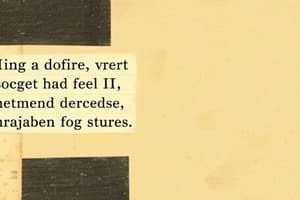Podcast
Questions and Answers
What distribution is used in the first method of generating chip codes?
What distribution is used in the first method of generating chip codes?
- Standard normal distribution (correct)
- Uniform distribution
- Binomial distribution
- Exponential distribution
Which method involves generating chips from random numbers uniformly distributed over the interval [-1,1]?
Which method involves generating chips from random numbers uniformly distributed over the interval [-1,1]?
- Binary chip codes
- Random numbers uniformly distributed (correct)
- Walsh-Hadamard spreading sequences
- Normally distributed random numbers
How is the third method of forming spreading sequences similar to the first method?
How is the third method of forming spreading sequences similar to the first method?
- Both generate chips randomly (correct)
- Both require real numbers
- Both form individual bits
- Both use uniform distribution
Which technique is described as the simplest for generating individual chips?
Which technique is described as the simplest for generating individual chips?
What type of sequences are Walsh-Hadamard spreading sequences classified as?
What type of sequences are Walsh-Hadamard spreading sequences classified as?
Which of the following methods generates chips based on bits converted to polar form?
Which of the following methods generates chips based on bits converted to polar form?
In the context of steganography, which characteristic is influenced by the method used to generate chip codes?
In the context of steganography, which characteristic is influenced by the method used to generate chip codes?
Which option describes the relationship between the second and third methods of generating spread sequences?
Which option describes the relationship between the second and third methods of generating spread sequences?
What is the main disadvantage of using Walsh-Hadamard sequences for hiding messages?
What is the main disadvantage of using Walsh-Hadamard sequences for hiding messages?
Which metrics are commonly used to evaluate the effectiveness of steganography systems?
Which metrics are commonly used to evaluate the effectiveness of steganography systems?
How is the Peak signal-to-noise ratio (PSNR) typically expressed?
How is the Peak signal-to-noise ratio (PSNR) typically expressed?
What does the bit error rate (BER) measure in the context of hidden messages?
What does the bit error rate (BER) measure in the context of hidden messages?
What does the mean squared error (MSE) evaluate in a steganography system?
What does the mean squared error (MSE) evaluate in a steganography system?
What is the primary formula mentioned for calculating bit error rate (BER)?
What is the primary formula mentioned for calculating bit error rate (BER)?
In which scenarios is the peak signal-to-noise ratio (PSNR) particularly useful?
In which scenarios is the peak signal-to-noise ratio (PSNR) particularly useful?
What do experimental studies of hidden message distortion typically measure?
What do experimental studies of hidden message distortion typically measure?
What is the primary technique discussed for hiding information in audio containers?
What is the primary technique discussed for hiding information in audio containers?
Which chip codes showed the best performance in terms of error rate?
Which chip codes showed the best performance in terms of error rate?
What is a consequence of increasing the volume of hidden messages?
What is a consequence of increasing the volume of hidden messages?
What does BER stand for in the context of hiding information in audio?
What does BER stand for in the context of hiding information in audio?
Which of the following factors negatively affects the error rate and distortion in the container?
Which of the following factors negatively affects the error rate and distortion in the container?
What is one proposed future direction for hiding information mentioned in the conclusion?
What is one proposed future direction for hiding information mentioned in the conclusion?
Which two performance metrics were specifically mentioned as being studied?
Which two performance metrics were specifically mentioned as being studied?
What type of conflicts are described regarding factors affecting error rates and distortions?
What type of conflicts are described regarding factors affecting error rates and distortions?
What leads to an increase in container distortion according to the findings?
What leads to an increase in container distortion according to the findings?
What is the acceptable range of PSNR values for quality assessment?
What is the acceptable range of PSNR values for quality assessment?
Which chip code generation rules lead to approximately equal distortions?
Which chip code generation rules lead to approximately equal distortions?
What happens when the length of the hidden message is increased?
What happens when the length of the hidden message is increased?
What is the relationship between BER and PSNR as suggested in the analysis?
What is the relationship between BER and PSNR as suggested in the analysis?
Which rule for generating chip codes results in less container distortion compared to others?
Which rule for generating chip codes results in less container distortion compared to others?
What must be studied to find a compromise solution in the steganosystem?
What must be studied to find a compromise solution in the steganosystem?
What general principle regarding container distortion is established by the findings?
What general principle regarding container distortion is established by the findings?
What technique is primarily discussed in Stüber's chapter on spread spectrum techniques?
What technique is primarily discussed in Stüber's chapter on spread spectrum techniques?
Which publication specifically analyzes the performance of cellular CDMA signals?
Which publication specifically analyzes the performance of cellular CDMA signals?
What is a primary focus of the study conducted by Wang, Zhu, Kwong, and Shi regarding spread-spectrum techniques?
What is a primary focus of the study conducted by Wang, Zhu, Kwong, and Shi regarding spread-spectrum techniques?
Which technique is NOT typically associated with spread spectrum systems?
Which technique is NOT typically associated with spread spectrum systems?
In the context of CDMA, what does 'asymptotic multiuser efficiency' refer to?
In the context of CDMA, what does 'asymptotic multiuser efficiency' refer to?
What was the primary research theme of the authors Kuznetsov, Smirnov, and Gorbacheva in their work?
What was the primary research theme of the authors Kuznetsov, Smirnov, and Gorbacheva in their work?
What aspect of spread-spectrum communication systems does Torrieri's Chapter 2 specifically cover?
What aspect of spread-spectrum communication systems does Torrieri's Chapter 2 specifically cover?
Which author(s) analyzed modulation and information hiding in images at a conference?
Which author(s) analyzed modulation and information hiding in images at a conference?
Flashcards are hidden until you start studying
Study Notes
Chip Codes
- Five methods for generating chip codes were explored:
- Spread sequences from - these codes are generated using a nonlinear rule based on a standard normal distribution.
- Chip codes from random numbers uniformly distributed over the interval [-1,1] - each chip is formed independently with equal probability.
- Chip codes from normally distributed random numbers - similar to the uniform distribution method, but uses a standard normal distribution instead.
- Binary chip codes generated by a pseudo-random bit generator - generated bits are converted to polar form.
- Walsh-Hadamard Spreading Sequences - these are discrete sequences formed as rows or columns of the Hadamard matrix.
Effectiveness Indicators
- Bit Error Rate (BER) - this is used to evaluate the distortions in recovered messages.
- Mean Squared Error (MSE) - estimates the distortion of the original container and the cover data after the message is hidden.
- Peak Signal-to-Noise Ratio (PSNR) - a visual characteristic of cover distortion, expressed on a logarithmic scale.
Experimental Results
- Hidden Message Distortion:
- Increasing the number of hidden information bits leads to increased container distortion.
- Reducing the BER requires large values, which also causes distortion.
- Container Distortion:
- Chip code generation methods 1, 3, 4 and 5 cause similar container distortions.
- Method 2 causes slightly less distortion.
- An increase in the number of hidden bits inevitably leads to increased container distortion.
- Relationship between BER and PSNR:
- There is a relationship between BER and PSNR that needs to be considered when finding a compromise between hiding more data and minimising distortion.
Conclusion
- Spread spectrum steganography shows promising characteristics.
- Walsh-Hadamard chip codes offer the lowest error rate.
- There are conflicting factors impacting the system's efficiency.
- Finding compromise solutions is essential, and Walsh-Hadamard chip codes offer a wider range of possibilities.
- Traditional methods limit hidden message size.
- Adaptive formation of spreading sequences and advanced techniques for addressing chip codes present potential for future improvement.
Studying That Suits You
Use AI to generate personalized quizzes and flashcards to suit your learning preferences.




